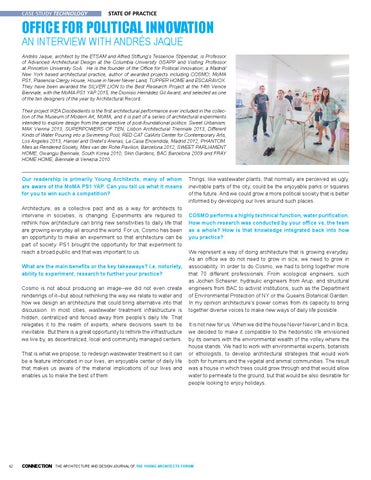CASE STUDY TECHNOLOGY
STATE OF PRACTICE
OFFICE FOR POLITICAL INNOVATION AN INTERVIEW WITH ANDRÉS JAQUE
Andrés Jaque, architect by the ETSAM and Alfred Stiftung’s Tessenow Stipendiat, is Professor of Advanced Architectural Design at the Columbia University GSAPP and Visiting Professor at Princeton University SoA. He is the founder of the Office for Political Innovation; a Madrid/ New York based architectural practice, author of awarded projects including COSMO, MoMA PS1, Plasencia Clergy House, House in Never Never Land, TUPPER HOME and ESCARAVOX. They have been awarded the SILVER LION to the Best Research Project at the 14th Venice Biennale, with the MoMA PS1 YAP 2015, the Dionisio Hernádez Gil Award, and selected as one of the ten designers of the year by Architectural Record. Their project IKEA Disobedients is the first architectural performance ever included in the collection of the Museum of Modern Art, MoMA, and it is part of a series of architectural experiments intended to explore design from the perspective of post-foundational politics: Sweet Urbanism, MAK Vienna 2013, SUPERPOWERS OF TEN, Lisbon Architectural Triennale 2013, Different Kinds of Water Pouring into a Swimming Pool, RED CAT CalArts Center for Contemporary Arts, Los Angeles 2013, Hansel and Gretel’s Arenas, La Casa Encendida, Madrid 2012, PHANTOM. Mies as Rendered Society, Mies van der Rohe Pavilion, Barcelona 2012, SWEET PARLIAMENT HOME, Gwangju Biennale, South Korea 2010, Skin Gardens, BAC Barcelona 2009 and FRAY HOME HOME, Biennale di Venezia 2010.
Our readership is primarily Young Architects, many of whom are aware of the MoMA PS1 YAP. Can you tell us what it means for you to win such a competition? Architecture, as a collective pact and as a way for architects to intervene in societies, is changing. Experiments are required to rethink how architecture can bring new sensitivities to daily life that are growing everyday all around the world. For us, Cosmo has been an opportunity to make an experiment so that architecture can be part of society. PS1 brought the opportunity for that experiment to reach a broad public and that was important to us. What are the main benefits or the key takeaways? i.e. notoriety, ability to experiment, research to further your practice? Cosmo is not about producing an image--we did not even create renderings of it--but about rethinking the way we relate to water and how we design an architecture that could bring alternative into that discussion. In most cities, wastewater treatment infrastructure is hidden, centralized and fenced away from people’s daily life. That relegates it to the realm of experts, where decisions seem to be inevitable. But there is a great opportunity to rethink the infrastructure we live by, as decentralized, local and community managed centers. That is what we propose; to redesign wastewater treatment so it can be a feature imbricated in our lives, an enjoyable center of daily life that makes us aware of the material implications of our lives and enables us to make the best of them.
42
CONNECTION
Things, like wastewater plants, that normally are perceived as ugly, inevitable parts of the city, could be the enjoyable parks or squares of the future. And we could grow a more political society that is better informed by developing our lives around such places. COSMO performs a highly technical function, water purification. How much research was conducted by your office vs. the team as a whole? How is that knowledge integrated back into how you practice? We represent a way of doing architecture that is growing everyday. As an office we do not need to grow in size, we need to grow in associability. In order to do Cosmo, we had to bring together more that 70 different professionals. From ecological engineers, such as Jochen Scheerer, hydraulic engineers from Arup, and structural engineers from BAC to activist institutions, such as the Department of Environmental Protection of NY or the Queens Botanical Garden. In my opinion architecture’s power comes from its capacity to bring together diverse voices to make new ways of daily life possible. It is not new for us. When we did the house Never Never Land in Ibiza, we decided to make it compatible to the hedonistic life envisioned by its owners with the environmental wealth of the volley where the house stands. We had to work with environmental experts, botanists or ethologists, to develop architectural strategies that would work both for humans and the vegetal and animal communities. The result was a house in which trees could grow through and that would allow water to permeate to the ground, but that would be also desirable for people looking to enjoy holidays.
THE ARCHITECTURE AND DESIGN JOURNAL OF THE YOUNG ARCHITECTS FORUM
